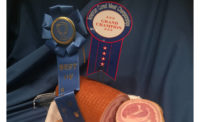
There is an old adage, you have to please the eyes first, that reminds us of the importance of color in cured meat products. It is highly desirable to have a bright pink color in ham, bacon and cured sausages. In order to understand cured meat color one must have an understanding of the curing reaction.
The most basic definition of cured meat is meat to which nitrite has been added during manufacture. Traditionally the nitrite is the result of direct addition of sodium nitrite during manufacture. The nitrite may also be derived from the addition of ingredients that naturally contain a high level of nitrate. The most commonly used ingredients naturally high in nitrate are celery powder or celery juice.
We typically add nitrite to meat products for flavor and color development. Nitrite in combination with the salt used in cured meat products also has a bacteriostatic (inhibiting growth) effect on microorganisms.
Myoglobin is the muscle pigment that gives meat its color. When meat is first cut, it has a purple-red color. When the pigment myoglobin combines with oxygen, oxymyoglobin is formed which is the typical color of fresh meat (bright pink in pork and bright cherry red in beef).
When nitrite is added to meat it will be eventually converted to nitric oxide, however, reduction to nitric oxide is often accelerated by the use of cure accelerators such as sodium erythorbate or sodium ascorbate. When nitric oxide is formed it combines with the pigment myoglobin to produce nitrosomyoglobin. Nitrosomyoglobin is the dark red color of cured meat which has not been heated. When nitrosomyglobin is exposed to heat, nitrosohemochrome is formed. Nitrosohemochrome is the pink color, typical of cured meats.
Basic Curing Reaction
The stability of the nitrosohemochrome pigment is influenced by oxygen, light and the percent of total myoglobin pigment that is converted to nitrosohemochrome. You never convert all of the pigment but rather a percentage of it. The higher the percentage of pigment you convert the more stable will be your cured color. This pigment conversion takes time which is why often processors build in a holding period during manufacture between starting the curing reaction and heating.Processors may hold injected hams for a day or stuffed smoked sausage overnight. Items which are cooked very rapidly may develop an initial good cured color.
However, the color may lack stability. Examples of scenarios where products can be potentially cooked very rapidly include water cooking and continuous smokehouses. Fading of the desirable pink color also occurs very rapidly when cured products are exposed to light and oxygen. This is of particular concern in sliced ham, bacon and cured sausage products. Consequently, these products are generally packaged to exclude atmospheric oxygen during storage and merchandising.
Reaction for Loss of Cured Meat Color
Oxidized porphyrins is the green, yellow, colorless appearance of faded cured products.Remember: The best we can do is size up the chances, calculate the risks involved, estimate our ability to deal with them and then make our plans with confidence.
Have a question forCordray’s Corner?
Dr. Joe Cordray is the Extension Meat Specialist at Iowa State University. He previously published Cordray’s Corner forMeat Business Magazinein the 1980s and ‘90s.


Report Abusive Comment